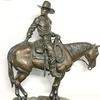Chinese Headrests Make For Good Pillow Talk
- NEW YORK, New York
- /
- August 24, 2017
The small, personal items from China's long history are as fascinating to collectors as paintings and ceramics. Take, for instance, the "pillow" collection coming to auction at Gianguan Auctions on September 9.
While they may appear to be uncomfortable, these headrests, in use from about the 6th century to the end of the 19th century, were both practical and of ritual use.
According to scholars at the Victoria and Albert Museum in London, during the early part of the 20th century railroad projects exposed graves from which many burial wares were unearthed and removed by foreign engineers such as Johan Gunnar Andersson (1874-1960). Previously unknown in the West, they became objects of interest to collectors. (The V&A houses a large collection of Chinese headrests.)
Among the early items in the Gianguan auction is Lot 254, a Warring States (475-221 BC) jade rarity. The ruyi shaped headrest hovers above two hogs at rest. It is carved oveall with zoomorphic masks. Pillows in animal forms were believed to ward off evil spirits and enhance peace and wellness.
Ceramic pillows, first manufactured during the Tang dynasty (618-907), became popular among the middle and upper classes of Chinese society. Particularly popular were Cizhu pillows. Gianguan offers a Song (960-1279) Cizhou porcelain pillow of heart shape. It is decorated ivory, black and brown slip, and is Lot 273.
By the Ming Dynasty, pillows were the subject of Chinese guides to elegant living. GaoLian authored one such guide, the Zun sheng bajian (Eight Discourses on the Art of Elegant Living), published in 1591. While he advocated for porcelain pillows that the middle classes could afford, the elite would have demanded pillows carved of jade.
One such jadeite pillow is Lot 156, an adorable Ming-carved boy laying on his stomach. (This form is frequently seen in porcelain but the jadeite version is rare.)
The importance of the Chinese bed cannot be overestimated. Historians suh as Sarah Handler have written that it was a space in which women pursued leisurely activities such as reading, writing, sewing or playing music. Men had their desks.
In wealthy families the bed was dowry, on display in neighborhoods to showcase a family's wealth as they were carried to the groom's house. Other objects that came in a bride’s dowry were bedcovers and curtains, other furniture, clothes and make-up and–quite possibly–pillows.
Today collectors view the pillows as decorative objects to be admired for their form and craftsmanship.
The Chinese pillows range in value from $3,000-$8,000. For full details, please visit the catalog at www.gianguanauctions.com or at www.invaluable.com.
















